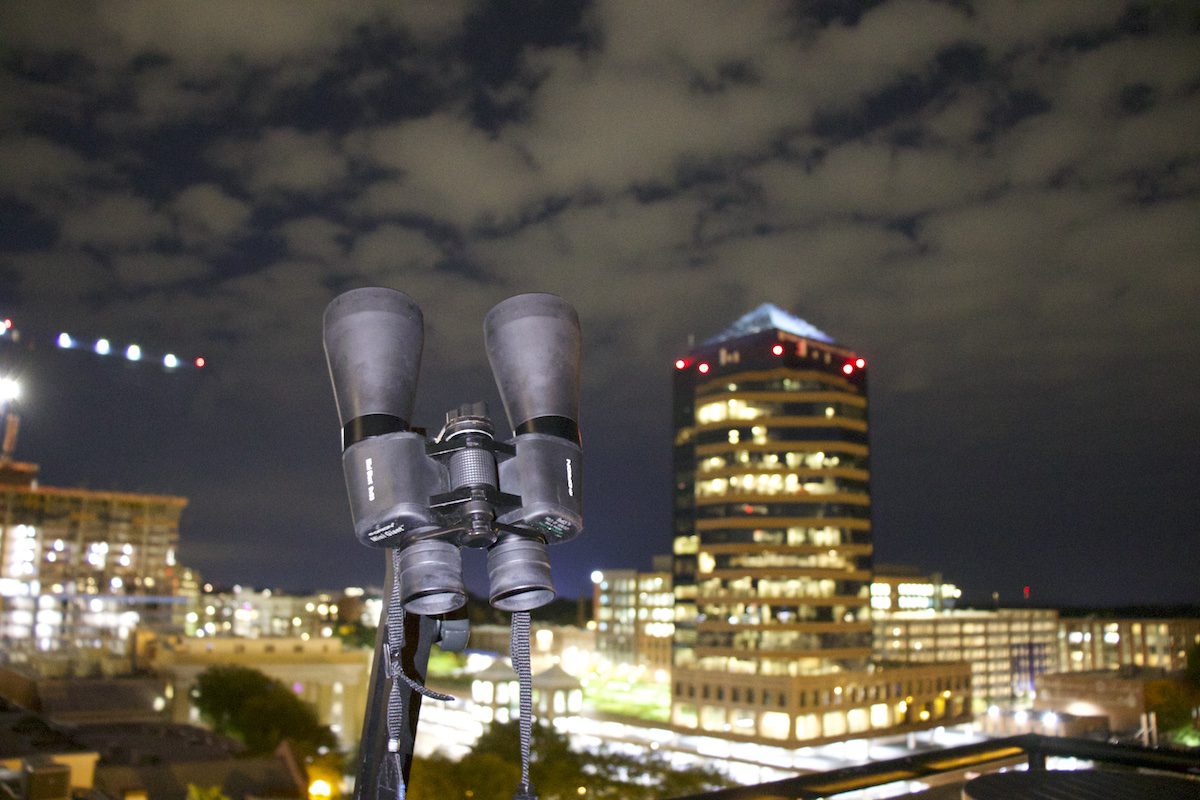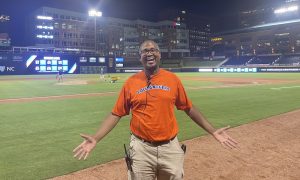Three generations of the Jabba family take turns peering through the eyepiece of a telescope aimed at Monday night’s waxing gibbous. Through the lens, the lunar landscape is unveiled in marvelous detail, occasionally interrupted by whispers of clouds swirling in front. It is the first time 8-year-old Samai Jabba and his grandfather, Panduranga Jabba, have seen the moon beyond the limits of their naked eyes.
On the rooftop at The Durham Hotel, Samai retreats to their table’s chips and guac, beaming with excitement. His father, Sairam, a 44-year-old research scientist at Duke University, is already well-acquainted with the orb’s craters. However, Panduranga’s enthusiasm rivals his grandson’s.
“He just kept saying… as soon as he saw [the moon], some of the parts were as sparkly as diamonds,” says Sairam, who translates because Panduranga does not speak English.
The occasion is “Views from The Durham,” when UNC-Chapel Hill’s Morehead Planetarium and Science Center joins the modern boutique hotel to give Durhamites of all ages new glimpses of the heavens. First booze, then binoculars.
Edison bulb string lights and glowing orbs are draped overhead, reminiscent of planets and other celestial spectacles. Michael English, “DJ Mic Check,” plays the latest pop hits (missed opportunity for Bonnie Tyler’s “Total Eclipse of the Heart”) while patrons dance between the tables, telescopes, and the planetarium’s information booths.
The event is free for the public. Hence, the rooftop hosts children in dinosaur pajamas and young adults in bodycon dresses and “It’s my birthday!” sashes.
The planetarium staff’s bright blue T-shirts announce “Science for All,” the text hugging an icon of Saturn. Tables are set up with Morehead swag and star charts, gradually ushering amateur astronomers to a meteorite-detection station. A buffet of different-colored rocks and small magnets rests on a lime green tablecloth.
The staff, two UNC undergrads, greets adults and children with the same question: “What do you know about meteorites?” Few know the answer: meteoroids become meteorites only if they survive the fiery journey through Earth’s atmosphere and hit the ground. So, the crust of freshly fallen meteorites tends to be black.
Guests also learn that meteorites are packed with iron and dense minerals, making them both heavy and magnetic. That’s where the magnets come in handy. When guests are rewarded with the satisfying click of a magnet smacking metal, they know they’ve spotted a meteorite.
About 9:45 p.m., just 45 minutes after sky viewing began, the moon ducks behind a curtain of clouds. Clear plastic is placed over the end of the telescope to protect the lens from dust.
Stargazers of the legal drinking age interpret this as cosmic intervention, an invitation to return to the bar. A little girl in bright pink orbits in front of DJ Mic Check, spinning in time with his tunes.

Morehead Planetarium hosts free public skywatching events about once a month, as long as the clouds allow. “I love getting to show people their first glimpse of something,” says Amy Sayle, a science education specialist from the planetarium. “There’s a lot of adults who have never seen the moon through binoculars or a telescope and didn’t even realize they could see craters.”
Back at the table, meteorites have been replaced with foam balls and a hair dryer. A wire basket full of the balls rests on stilts. In the basket’s center, there is a clear canister waiting to catch the balls as the hair dryer blows up air from below.
The foam balls represent gas molecules. When the aspiring scientists use the hairdryer to blow the foam balls into the glass canister, the “gas” condenses. How full the canister gets determines which kind of star is made. A ton of super-dense gas results in a massive supernova.
A mother and her two sons, the older dressed as Spider-Man, the younger as Captain America, approach to try their success at making a star. Spider-Man takes three tries, the hair tool awkward in his small hand, before he’s condensed enough gas to make a supernova. Giddy (and most likely up past his bedtime), he bounces up and down just as energetically as the foam gas molecules. “WHOA!” he says, starry-eyed.
By a quarter past 10, the moon has traveled to the opposite side of the roof, and Morehead staffers move the telescope to keep up. Saturn, like the moon, plays peek-a-boo until the clouds part just long enough so that the skygazers can spot them.
“Wait 60 seconds maybe,” says UNC sophomore Minh Nguyen, “I don’t want you to leave without seeing Saturn.”
The telescope serves as a portal to witness what lies about 1.3 billion kilometers beyond. Fluttering open an eyelid, there Saturn hangs— a pinpoint of light with a single thread gracefully circling the orb’s roundest point.
Photo at top: A pair of binoculars looks skyward at “Views from The Durham,” an event at the downtown hotel with UNC-Chapel Hill’s Morehead Planetarium and Science Center. Photo by Maddie Wray — The 9th Street Journal






